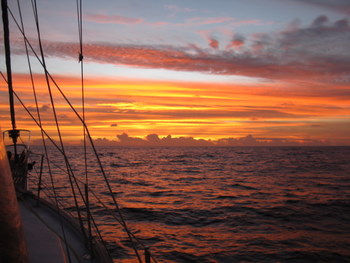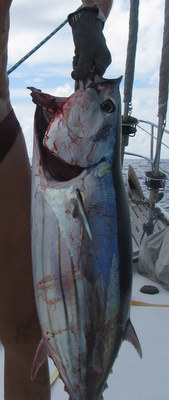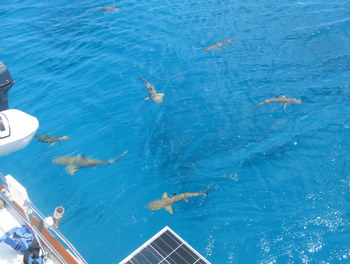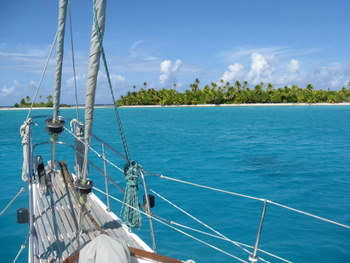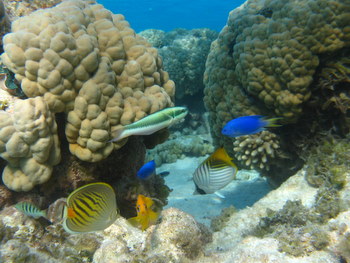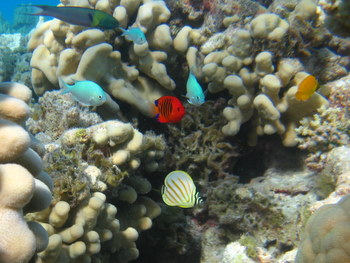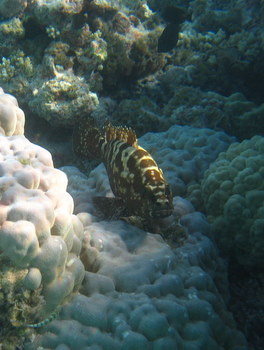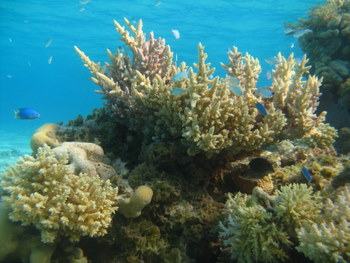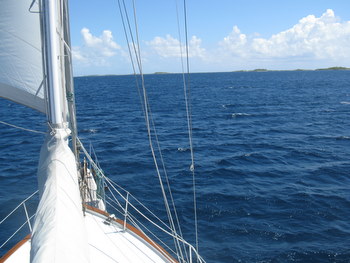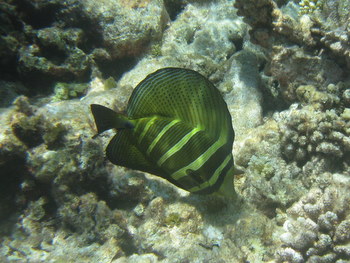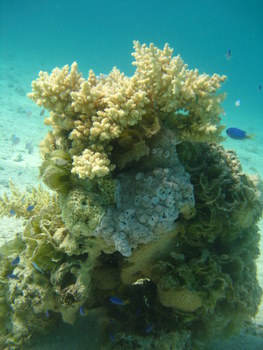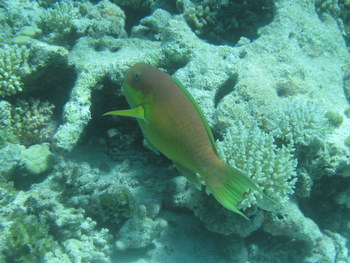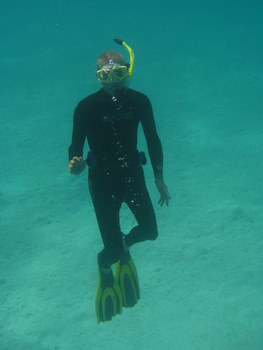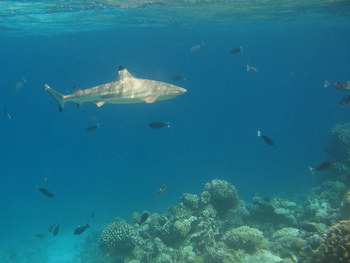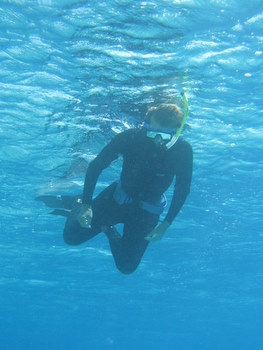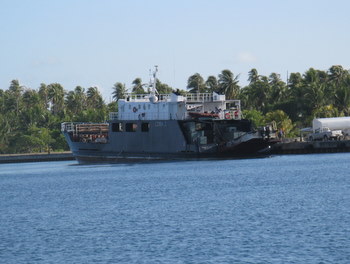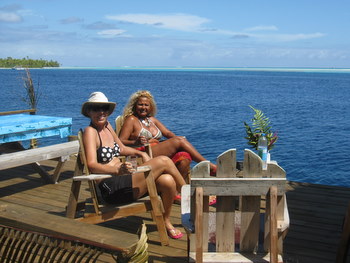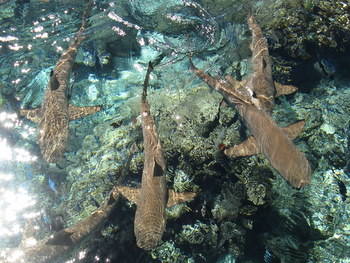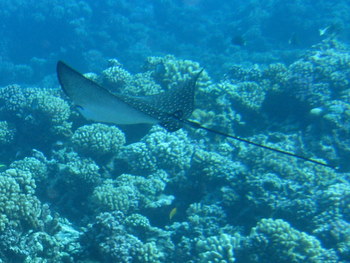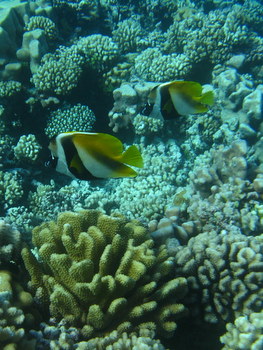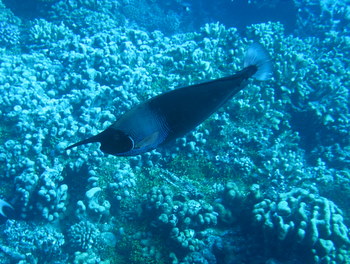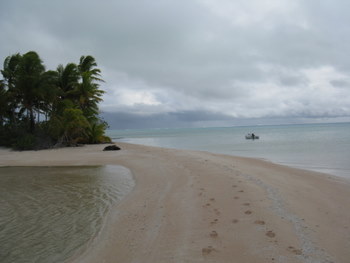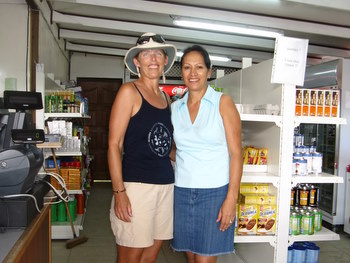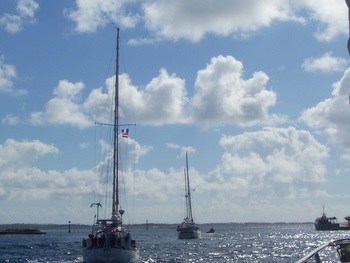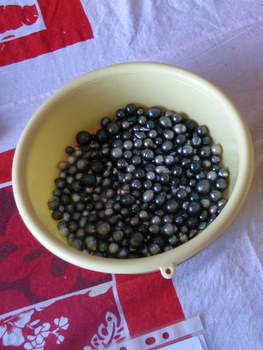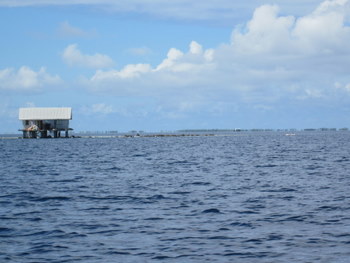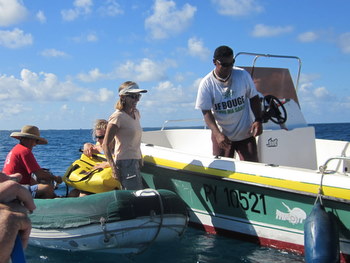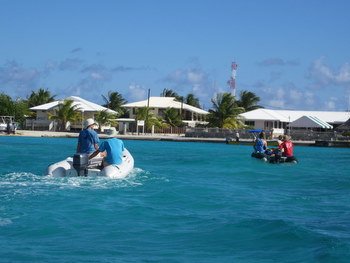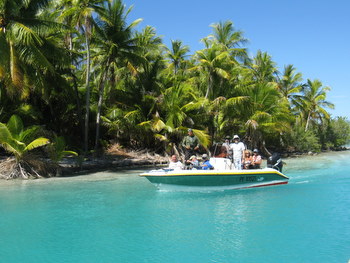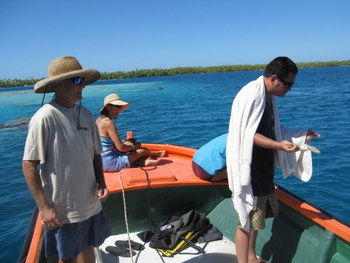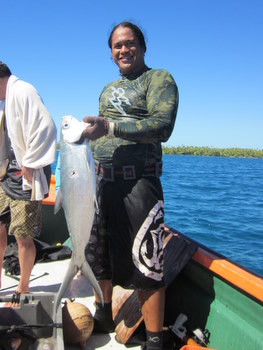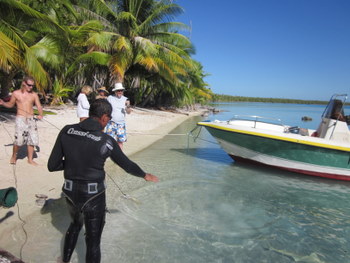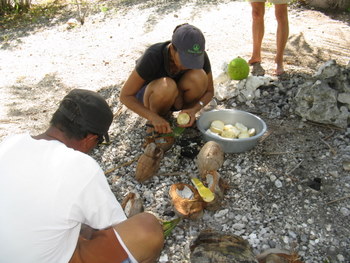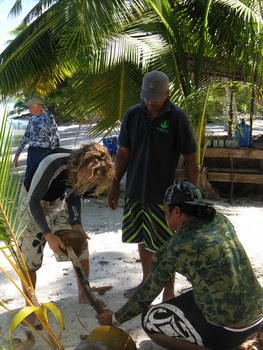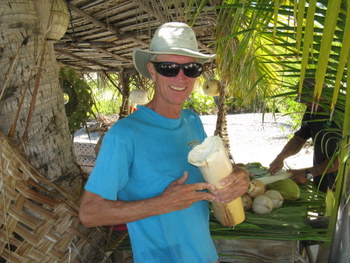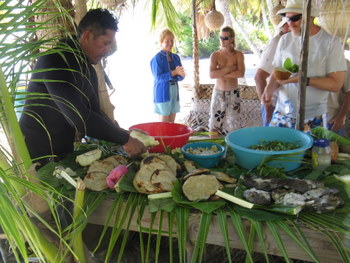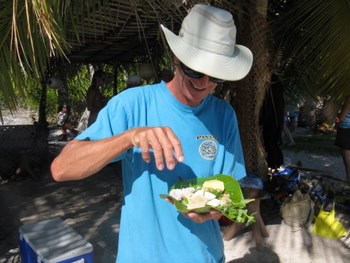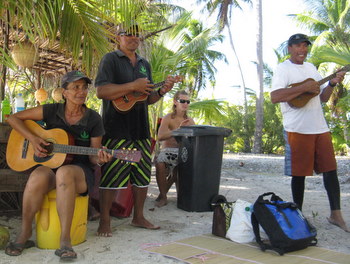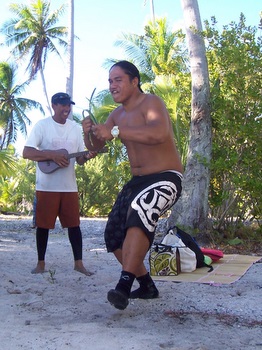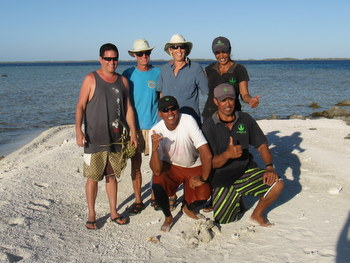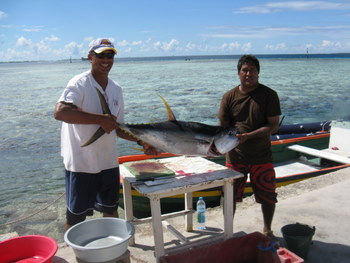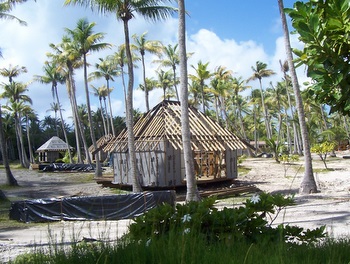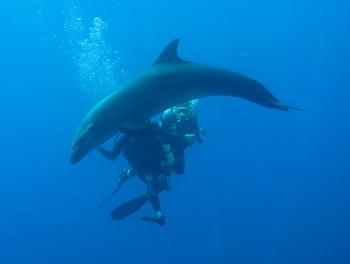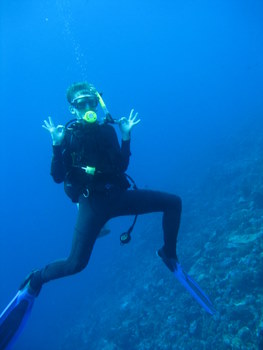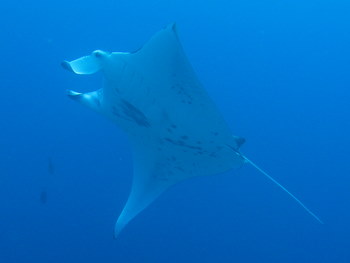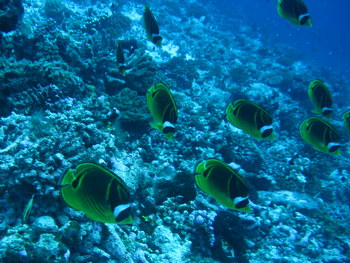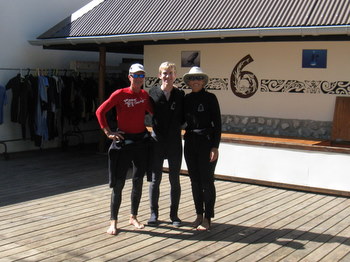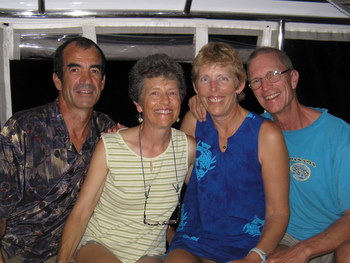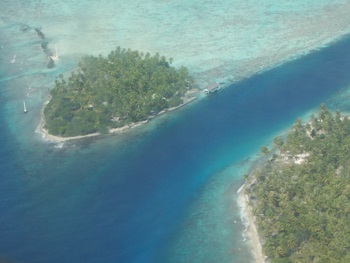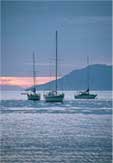
Current Location
(enter callsign KG6NNZ)
Logbook: Tuamotu Archipelago - Tahanea, Fakarava, Manihi and Rangiroa Atolls - April to June 2011
| In February, March and early
April, we were in Tahiti and Moorea focusing primarily on boat repairs and maintenance,
starting up all of our systems and ensuring they were running properly, and shopping and stocking up on provisions in preparation for the next
couple of months which we
would spend in the Tuamotu Archipelago.
The Tuamotus are very remote - there are 78 islands scattered across almost 350,000 square miles of ocean. All but two of them are atolls - rings of small islands (motus) and reef surrounding a lagoon. Some of them are uninhabited and even the most populous ones have only small villages ashore. They offer fabulous snorkeling and scuba diving, and we were looking forward to spending time in and under the water. We would only have time to see a few of the atolls - it would take years to explore all of them. We were eager to be on our way! Passage from Opunohu Bay, Moorea (Society Islands) to Fakarava Atoll - North Pass (Tuamotu Archipelago) (April 10-12, 271 nm, 49½ hours). When we left Moorea headed for the Tuamotus, we weren't sure of our exact destination. We had several atolls in mind, depending on how strong the winds blew and from what direction. We were heading east into the prevailing tradewinds, but we had a forecast of light and variable winds for the next couple of days. We were hoping to make it to Makemo, but that was the furthest away (almost 400 nautical miles), so we had other closer options of Fakarava, Tahanea and Rangiroa. Other issues that would factor into our ultimate decision included trying to arrive at an atoll during daylight hours and timing the tide for entering the pass into the atoll's lagoon. |
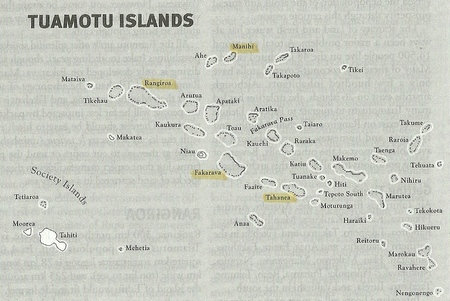 |
We departed Opunohu Bay late morning with light winds blowing from the west-northwest and flat seas - fantastic! We put up the main, mizzen and headsail, and were sailing quite nicely, albeit slowly, toward our desired destination. That lasted all of about 45 minutes, and as we approached the channel separating the islands of Moorea and Tahiti, the wind shifted to the east-northeast and increased to about 10 knots. We doused the mizzen and headsail, turned on the engine and motored into it. An hour later, along the north coast of Tahiti, the wind increased to 15-20 knots and the seas got bigger, so we unfurled the headsail, reefed the main, turned off the engine and sailed north - not exactly the direction we wanted to go, but we preferred to be sailing and not bashing head-on into the building seas. A few hours later, the wind backed to the north, and we tacked and were happily again sailing in the direction we wanted to go. As the afternoon wore on, the winds slowly lightened up, and the seas got less lumpy. Around sunset on the first evening of our passage, as we were approaching the east end of the island of Tahiti, the winds veered to the northeast, almost on our nose, but they died down to 7-8 knots, and we furled the headsail and once again turned on the engine. For the next day and a half, the
winds remained very light (5-10 knots), the seas were quite calm, and we
motored. As it became apparent that this passage would be mostly a motor
trip, we eliminated Makemo as a destination because it was too far, and we didn't want to burn that much fuel.
Distance-wise, Tahanea
or Fakarava (north or south pass) were good options. Although our first choice was Tahanea,
the timing was such that we would arrive there in the middle of the night - not
good. It was looking like the north pass of Fakarava would be the best
option - we could arrive there in daylight and at just about the right time for
slack water, so we adjusted our course and headed in that direction. |
|
| As it turned out, there was
another reason for us to choose North Fakarava as our destination. While
underway, when we tried our SSB radio email, it would not work. We knew
that North Fakarava has internet
service, so we could send an email to our families to let them know we arrived
safely. Since we had had constant internet access for the past couple of
months for email and no one to talk to on the SSB, we had overlooked
testing the radio to see if it worked - and it did not!
On our second morning out, we ended the losing streak we had with fishing which started over a year ago. Since arriving back in the Pacific last year, we had landed only a couple of fish, which were too small so we threw back. We had hooked a few larger fish, but all of them got away, most of the time taking our lures with them. While back in the U.S., our friend Paul Gryce who used to live in California, but now lives in Louisville, Kentucky, gave us one of his fishing rods and a tackle box full of great lures, saying he had no use for them in Kentucky - lucky us! Also, our friend Steve Nall bought Rich a new reel after Rich helped him with some of his boat projects. So, now we were dragging two lines from two rods and reels off the stern of Slip Away. That morning, we almost hit the jackpot - both lines went off at the same time! Rich was on watch, and Jan was sleeping, so Rich tightened down the drag on both reels, woke up Jan, and then proceeded to start to reel in one of the lines. Jan got the gaff ready, and on the first line, Rich reeled in a good-sized skipjack tuna. Jan gaffed it, and we got it on board. In the meantime, the fish on the other line got away. Darn! But, we got one, and we were happy about that. Ironically, we landed the fish with our old rod and reel. We estimate that the tuna weighed 25 lbs. because we got almost 10 lbs. of filets off him. We had tuna for dinner that evening - yum! When we arrived at the North Fakarava Pass, our timing could not have been better. We arrived mid-morning, one hour before the estimated high tide, and the pass was flat calm - quite a different situation than we experienced last year when we bashed into standing waves and bent our bowsprit! We motored through the pass, and headed toward the anchorage off the village of Rotoava. Rotoava, North Fakarava (April 12-13). We spent only one night at North Fakarava - just long enough to send off an email letting our families know we made it OK , get a good night's rest, visit the Boulangerie Havaiki (our favorite bakery) to pick up some fresh baguettes and chocolate croissants, and buy a new black pearl pendant for Jan since she gave away the one she bought last year. The winds were forecast to be fairly light for another day or so, but the tradewinds would be reestablishing soon, so we decided to continue on to Tahanea (about 85 miles southeast of North Fakarava) before they got too strong. |
|
Passage to Tahanea Atoll (April 13-14, 93½ miles, 19 hours). Our departure from the North Fakarava pass was not as smooth as our entrance, but it wasn't bad, and we made it through with only a few splashes of water on the deck.
Once outside the atoll, we needed to head northeast for a few miles to clear the corner of Fakarava before turning southeast toward Tahanea. We were able to sail on a close reach for about an hour with 8-10 knots of wind and light seas - very pleasant! When we made the corner, we turned southeast and the engine came on. Shortly afterward, we were hit by a squall with 20-25 knots of wind and rain that poured down for about 45 minutes. After the squall, the winds were calm for an hour or so, and then they came up to about 15 knots from the east - about 30 degrees off our bow, too close for us to sail, so we motored on. The seas seemed rougher than they should have been - at times slowing us down so much that we were concerned we would not make the morning slack water at the Tahanea pass, and also making it difficult for the off-watch person to sleep. After several hours, the seas finally calmed down, so the ride became more comfortable, and we started making better time. We ended up arriving at the Tahanea pass about two hours before the forecasted high tide, and once again we were looking at a completely flat calm pass. Yahoo! We proceeded in with about 2.5 knots of incoming current and found our way to the anchorage.
Tahanea Atoll (April 14-25). Tahanea is about 25 miles long and 8 miles across, and has three deep-water passes into the lagoon on its north side. There is a small village on this atoll, but from what we understand, it is only occupied for a couple of months each year during the copra (coconut) harvest. We don't know when that occurs, but it wasn't happening when we were there.
| Tahanea Atoll has been designated
as a Park, and we heard wonderful things about
it from friends who visited
last year. We were looking forward to clear waters, healthy and beautiful
corals and excellent fish life, and that is just what we found. We spent
11 days exploring this atoll, anchoring in three different places, enjoying a
couple of lovely sails across the calm waters of the lagoon and snorkeling every
day. When we first arrived, we saw one other sailboat and a powerboat
anchored nearby, but they both left
the next day. We didn't see another cruising boat until the day we left,
and in between, only a couple of times did we see a local boat, so we
pretty much had the place to ourselves. We entered the atoll through the center (reputedly easiest) pass, and dropped our hook in an anchorage just to the west side of the pass. Shortly afterward, we were greeted by a welcoming committee - of sharks! Six or eight blacktips started circling our boat. Hmm... This was a bit unsettling. Although we are used to seeing a few sharks when we snorkel or dive, we never before had them circling our boat. They apparently get fed here. Neither of us was volunteering to jump in the water with our mask and snorkel to check that our anchor was well set! We did take the dinghy to snorkel a spot not too far away, and although the sharks didn't bother us, Rich still felt they were a little too curious. |
|
A couple of days after we arrived at Tahanea, the tradewinds picked up (15-20 knots from the east), and the anchorage near the pass became rolly and uncomfortable, so we motored across the lagoon to the southeast end of the atoll (9.5 nm, 2 hours). Here, we found a nice calm anchorage and an outstanding snorkel spot - five to eight feet of some of the clearest water we've ever snorkeled in, with scattered coral heads and great fish life. We saw lots of juvenile fishes, especially several varieties of butterflyfishes, but we also saw some groupers which were quite large and curious. As we swam among the coral heads, the grouper would come out of their hiding places and check us out. Some of the reef fishes in the South Pacific, especially the groupers, carry a disease called ciguatera, which makes them inedible unless you want to get really sick, so that limits spearfishing. These big groupers had obviously never been shot at because they had no fear.
|
|
|
|
|
|
|
| The next couple of times we
changed anchorages in the lagoon we were able to sail.
After weighing anchor, we unfurled the headsail and glided across flat waters -
very nice! Rich stayed on the foredeck and watched for random coral heads,
while Jan stayed at the helm to adjust our course if necessary. We stopped
at another anchorage on the east side of the atoll, and found some good
snorkeling there, although not as good as the previous spot. When the
winds appeared to be settling down, we headed back to the anchorage by the pass.
We were hoping to anchor near the east pass because we wanted to drift snorkel
through it, but that anchorage wasn't tenable in the 15 knots of east winds that
were blowing. So, we headed back to the anchorage by the center pass,
where we were once again greeted by the shark welcoming committee. We were really eager to snorkel the east pass, drifting in with the incoming tide. We'd heard it was the best. The incoming current brings crystal clear water and good fish life, and the corals in the east pass were supposed to be especially beautiful. The east pass was about 2 miles from the center pass, so we could get there by dinghy. It was a rough ride in the east winds, but definitely worthwhile. |
|
We had never done a drift snorkel, but we have done some drift dives in the past. Our previous drift dives were done with dive shops, and their support boat followed our bubbles and picked us up at the end. But for this we would be on our own, and we would need to tow our dinghy along with us as we drifted through the pass. We were both a little nervous before our first run, and Jan insisted that we each have our own line for hanging on to the dinghy. Shortly after dropping in the water on the outside of the pass, our fears were allayed, as we slowly floated along watching the corals and fishes below us. Our first drift through the pass took probably 20 minutes, and when we reached the end of the pass, we hopped back in the dinghy, motored back outside the pass and did it again, and again. We snorkeled the east side and the west side of the pass, and decided we preferred the east side. The sights were about the same, but the drift along the east side ended up in calm water, so we didn't have to hustle back in the dinghy as we approached the rips where the incoming current met the lagoon waters. With each trip through the pass we gained more confidence, and we started to take turns with one person holding on to the dinghy and the other one drifting unencumbered - no problem since everything pretty much drifted at the same speed. We had so much fun that we came back the next day - endured the rough dinghy ride once more and did the drift snorkel several more times. The water was crystal clear, the fish life was varied and plentiful, and the corals were beautiful!
Although we loved snorkeling through the east pass, we didn't particularly enjoy the dinghy ride to get there, so after a couple of trips, we decided to find a snorkel spot closer to home. There was a huge coral patch visible from the anchorage, about ¾ of a mile away. We hadn't heard any reports on whether this coral patch was good or bad, so we went exploring, and this ended up being one of our favorite spots. The visibility wasn't as clear as some of the other places, but it was still very good, and the fish life was excellent - lots and lots of different kinds of fishes. Jan's favorite sighting was a pair of two-tone dartfishes. They were way too shy for us to photograph, but she saw them a couple of times. We first snorkeled this sight the day before we were planning to leave Tahanea. If we had found it earlier, we probably would have gotten out our scuba gear to dive it. It was outstanding!
|
|
|
|
|
|
|
|
The time we spent in Tahanea was idyllic, and we got into a nice routine. Most mornings, we did yoga on the front deck - therapeutic for both body and soul! If we were moving to another anchorage, we'd set sail mid-morning so the sun was high in the sky, and we could see any potential obstructions in the water. Mornings and afternoons were spent snorkeling or doing some chores or reading. Although our radio was not working to transmit or do email, it was working as a receiver, and we connected our computer and set it up to download NOAA weather faxes, so we could keep any eye on the weather. At 5 p.m., we poured ourselves a happy hour drink and listened to the Pacific Seafarer's Net on our radio. A couple of our friends were on long passages and checking into that Net, so we kept track of their progress. Life was good!
We did have one nagging worry while we were in Tahanea. With our broken radio, and since there were no other boats around, we were out of touch with our families. If we had an emergency, we felt confident we could get help - worst case, we could set off our EPIRB (Emergency Positioning Radio Beacon) which would alert the Coast Guard. But our families had no way to reach us. We were feeling a need to get back to an internet connection just to check in and make sure everything was OK. When the time came to leave Tahanea, we once again headed back to North Fakarava.
Passage from Tahanea to North Fakarava (April 25-26, 89 nm, 19 hours). The distance from Tahanea to North Fakarava was such that we needed to leave on the late afternoon tide, which occurred on that day at about 4:30 p.m. During the previous night, the winds blew 20-25 knots, and we were thinking our sail back to Fakarava might be a lively one. But as the day went on the winds got lighter and lighter, and by the time we left, we had only 10-15 knots. It was coming from the right direction, so we could sail back to Fakarava, but the seas were still pretty lumpy from the high winds earlier in the day, and it wasn't particularly comfortable. The seas eventually smoothed out, but the wind continued to decrease until about 10 p.m. when we had only 8-12 knots, and we poked along at a snail's pace. However, by midnight the wind started building, and a few hours later we were moving along quite nicely in 15-20 knots. Once again, when we approached that northwest corner of Fakarava, the seas grew quite lumpy - we think that the currents flowing around that corner must make it lumpy all the time. Our entrance through the North Fakarava pass wasn't particularly smooth this time, but we once again entered the lagoon with no problems. Although we came back to North Fakarava for the internet, our intention for this visit was to spend some time exploring Fakarava Atoll.
Fakarava Atoll. Fakarava is the second largest atoll in the Tuamotus. It has a rectangular shape, 32 miles long and 15 miles wide, with 80 motus ringing the lagoon, and there are navigable passes at the north and south ends. The total population of Fakarava is about 500, and most everyone lives near the village of Rotoava located in the northeast corner of the atoll. Tourism is in the early stages of development here, and most folks who visit do so for the scuba diving. Fakarava and six other nearby atolls are a designated UNESCO Biosphere Reserve. There are also a number of black pearl farms in the lagoon, and one can buy pearls directly from them. We spent a couple of weeks at the north end of Fakarava last year, and we did a couple of dives - one on the wall outside the pass, and one through the pass. The dive through the north pass was outstanding, and this year we wanted to dive the south pass.
| North Fakarava (April 26-30). We intended to spend just a couple of
days in North Fakarava to use the internet to check in with our families (all of whom were just
fine), pick up a few fresh
provisions, and then head down to the south pass. However, we arrived
a couple of days after Easter, and there wasn't an egg or a fresh vegetable to
be had in the town of Rotoava. So we hung out a couple extra days and
waited for the arrival of the supply ship.
In the meantime, a couple of new boats came into the anchorage, and on one of them was a guy Rich knew in Los Angeles - Gary Malloy on s.v. Dash. Rich and Gary sailed together for a few months when Rich crewed during some races to get additional sailing experience. Gary had been following our travels and knew where we were, but we hadn't heard from him in several years, so we had no idea that he was in the area. Gary joined us for cocktails one evening on Slip Away, and we caught up and swapped stories. When the supply ship arrived, we picked up some fresh provisions. Given the scarcity of fresh veggies and high prices, we were glad we had a good stock of frozen and canned ones on board! The next morning, we headed south. |
|
Passage from North to South Fakarava (April 30 & May 1). With the right winds, traveling between the north and south ends of Fakarava atoll is a nice sail inside the lagoon. The distance is about 30 miles, which can be done in a day, but we wanted to stop at an anchorage along the way. The weather forecast was perfect - two days of fairly light north winds, which would be great for our sail south, and then the wind was supposed to veer to the east, which was just what we needed for a comfortable anchorage at the south end of the atoll.
We left North Fakarava mid-morning with 10 knots of wind from the north-northeast. We unfurled our jib and glided along on flat calm waters. We weren't going fast, but it was a very pleasant sail. We fired up the IPod and listened to and sang along with Kenny Chesney. Mid-afternoon, we found a nice anchorage that offered protection in north winds (near the motu Kaukuraroa) , and dropped our hook (16½ nm, 5 hours). There was a big coral head nearby, so after setting the anchor, we jumped in the water and went for a snorkel.
During the night, the winds built to about 15 knots, but the forecasts were still calling for them to veer to the east the next day, so we continued with our plans to head south. The second half of our trip was more lively with 15 to 20 knots of winds - stronger than we anticipated, but it was a good sail, and we headed to an anchorage on the southwest side of the pass (14½ nm, 3 hours). Others who had gone before us told us that a reef protected this anchorage in north winds, but it was still pretty lumpy as far as we were concerned! Fortunately, as forecast, the winds veered to the east that evening, and then it was quite comfortable.
South Fakarava (May 1 to 8). There's not much at South Fakarava - two very small pensions, one of them with a dive shop on the premises. But, we were here to scuba dive, and we had food on board, so we didn't need anything more. The diving at South Fakarava is reputedly some of the best in the world, and it's famous for the incredible number of sharks which hang out in the pass. At South Fakarava, one drift dives through the pass on the incoming current. Although we felt comfortable drift snorkeling on our own, we wanted to do our first couple of drift dives through this pass with the dive shop.
The morning after we arrived at South Fakarava, we dinghied up to the dock of the Tetamanu pension, and were greeted by the proprietress Annabelle. Annabelle was born in Tahiti, grew up in Hawaii and lived for several years in Santa Monica, California (not far from where we used to live). We had lots to talk about and enjoyed a nice visit with her. As we talked with Annabelle, her cook was cleaning fish for lunch, throwing the remains in the water just off the dock, and blacktip sharks were swarming around. Annabelle and her husband also own the dive shop, so after speaking with her, we met their diving instructor Jean Charles, and scheduled two drift dives for the next day.
|
|
|
While we were ashore, we took a walk around Tetamanu village. Tetamanu was once the capital of Fakarava, but it was abandoned after a destructive hurricane many years ago, and the capital was moved to Rotoava in the north. After our walk through the remains of the village, which took all of about 30 minutes, we decided to take advantage of the incoming current in the pass and do a drift snorkel. The fish life was good and we saw several sharks. We were looking forward to the dives the next day.
|
|
|
|
Although scuba diving with a bunch of sharks might sound like it's dangerous, usually it's not. There are some species of sharks, e.g. great whites and tiger sharks, which are quite aggressive, and if we saw any of those, we would be out of the water as quickly as possible. But, mostly we see black tip, white tip and grey reef sharks, and as long as one doesn't do anything stupid, they generally don't bother divers. One of our cruising guides gave the following advice: "Do not attach fish to your belt." Duh!!!
The following day was a bit of a splurge for us - two dives with the dive shop and lunch at the pension. Our timing was quite good because the tide started to come in mid-morning, so we had an opportunity to do an incoming drift dive both in the morning and the afternoon. When we arrived at the dive shop that morning, we were quite pleased to find that we were the only ones scheduled to dive, so we would have a personal tour with Jean Charles. This was the first time we were diving this season, and although we did some preventive maintenance on our scuba equipment in the U.S., we had a few issues with our gear, but between Rich and Jean Charles, they worked around the problems and we were ready to go. Both dives that day were very good - great fish life, beautiful corals, an eagle ray, a friendly turtle, a very cool little nudibranch and quite a few sharks (more on the second dive than on the first). Lunch was delicious - a buffet of Polynesian dishes and fresh fish - which was served at their very casual waterside dining room (a dock with a sheltered galley and picnic table).
As we talked over our dives that evening, we both agreed that these were very good dives, but neither of us felt like we saw as many sharks as we had expected to see. Jan actually tried counting the number of sharks on the second dive, and came up with about 50, which is a good number, but from what we heard from others, we thought we would see hundreds. We chalked it up to having set our expectations too high.
The next day, we felt confident enough to do the drift dive on our own, so we got our gear together and went, dragging our dinghy on a long tether. This time, we found them - literally hundreds of sharks hanging out in the pass with the incoming tide. There were way too many to count - incredible!! The next day, we went back and dove the pass again, but we missed the pack of sharks because we swam after a group of six eagle rays, four of them swimming in formation - another awesome sight! We were now totally hooked on the diving at South Fakarava and were excitedly planning to dive it a couple more times. Since we were feeling fairly comfortable with drift diving on our own, we wanted to bring our camera and get photos of all those sharks.
| But sometimes, Mother Nature has her own ideas. We'd had several days of settled weather and were lulled into thinking it would continue. We'd gotten complacent and hadn't downloaded the weather faxes for a couple of days and failed to anticipate a forecast of north winds which arrived during the night. The winds weren't exceptionally strong - about 15-20 knots - but a moderate sea builds up over the 30 miles of fetch from the north to south end of the atoll. Although a reef offered some protection to the anchorage, it was minimal, and the 2-3 foot waves made it uncomfortable and pretty much impossible to launch the dinghy and load up the dive gear while the boat was pitching and rolling. Since there was no internet at South Fakarava, we fired up our laptop, downloaded the NOAA weather faxes through our SSB radio, and on them we saw a couple of low pressure systems passing through our area. Later that afternoon, after the first low pressure system passed through, the north winds abated and the seas calmed down. It was too late for a dive, but we took the opportunity to get off the boat and go explore some of the pretty pink sand motus near the anchorage. That night, as the next low pressure system approached, the north winds came up again and lasted throughout most of the next day. We really wanted to dive the pass at least one more time, so we put off our departure for a day, thinking (or maybe it was just hoping) that these weather systems would move out of the area and we could get one last dive in. But, it was not to be. Although the north winds abated again late on the second day, they came up again that night. The next morning, as we sat pitching and rolling in the anchorage - and getting cranky from lack of sleep - we disappointedly weighed anchor and headed north. |
|
| Passage from South to North Fakarava (May 8
to 9). We motored north with
about 15 knots of wind on our nose and headed straight for the anchorage where we stopped on
our way south - near the motu Kaukuraroa (14½ nm, 3 hours).
This anchorage was quite comfortable in the north winds which blew all night,
and we slept like babies. The next morning, the winds had shifted a bit to the northeast, and
since we were actually traveling northwest, we were able to sail most of the way
back to Rotoava (16½ nm, 4 hours). Rotoava, North Fakarava (May 9-12). We spent a couple days in Rotoava picking up a few provisions and purchasing a few more black pearls. Jan loved the black pearls, and there was no better place to buy them than here. We were also keeping an eye on the weather, which looked good for us to move on to Manihi Atoll. Time was flying by - we had already spent a month in the Tuamotus. We were eager to see other atolls, but we also had mixed feelings about leaving Fakarava. We'd grown attached to this place and could have stayed much longer. The local people were very friendly, and we had grown especially fond of Coco and Margaret, the owners of the Boulangerie Havaiki. When we tried leaving, Fakarava didn't let us go easily - our anchor chain was caught on a coral head, and Jan had to don her snorkel gear and get in the water to free us up. |
|
Passage from North Fakarava to Manihi Atoll (May 12-13, 112 nm, 23 1/2 hours). We cleared the north pass of Fakarava with no problem in the late morning and set our course north-northwest to Manihi Atoll. We started out with about 15 knots of wind from the east and sailed with the jib and mizzen, but a couple hours later the winds lightened up, so we raised the mainsail too. As the sun set that evening, we reduced sail - dousing the mizzen and reefing the main. For most of the night, the winds were consistent at 12-15 knots from the east (on our beam), with only one small squall, and we sailed along at just over 5 knots. We arrived at the pass to enter Manihi at about 8 a.m., which was about an hour ahead of slack water, and we hovered around outside for a bit. There were two other boats on their way to Manihi (Sea Flyer arriving from Hawaii and Pua'Ena from the Marquesas). They arrived shortly after us, and a local guy named Fernando came out in his speed boat, welcomed us to Manihi and guided us through the pass and to the anchorage - a flat, calm easy pass entrance. There was only one boat in the anchorage when we arrived - s.v. Infini, with our friends Mike & Sue and their son Matt aboard. We had been in touch and were expecting to see them; they arrived the previous day from Hawaii.
Manihi Atoll (May 13-21). Manihi is one of the most northern atolls in the Tuamotus, and it is about 3½ miles wide by 18 miles long. The one navigable pass into the lagoon is situated on the west side of the atoll. At one point, there was a thriving black pearl industry here with about 60 pearl farms, but from what we understand, only a few are still operating. There are about 1,000 residents on Manihi, most of them living in or near the village of Paeua which is situated next to the pass. We'd heard mixed reviews from other cruisers about Manihi. It seemed that people either loved it or hated it, so we were curious what our impressions would be.
|
|
|
|
Our first impression was that this was not the prettiest atoll in the Tuamotus. The lagoons of the other atolls that we visited were blue, and the water in this anchorage was green. Also, when Sue & Matt from Infini snorkeled some coral heads near the anchorage, they told us the coral was mostly dead. However, our first impression was not the lasting impression we had of Manihi.
After getting settled in the anchorage, all four anchored boats loaded their crews into their dinghies (11 people) and headed into the village. We wanted to personally thank Fernando for his escort service, buy some bread from his bakery and check out the town. As we dinghied toward the village, we were met by a guy in a boat on his way to the anchorage - he was sent by Fernando to deliver baguettes to us. Infini had a large dry bag and loaded the baguettes into it, and we all continued toward town (which was about a mile away). We met Fernando at his home, which is also the site of his bakery.
|
|
|
Initially, we weren't quite sure what to make of Fernando. He showed us a list of prices for tours and services he offers - services such as escorting boats through the pass and to the anchorage, delivering baguettes to the anchorage, and tours such as a pearl farm tour and "blue lagoon" picnics. Although, we expected to offer him money for escorting us through the pass, we were not aware of any set charge, and the price on his list was a bit steeper than we anticipated. And, as soon as we arrived at his home, he was excitedly telling us that he wanted us all to come on a picnic tomorrow. Fernando's English is quite passable, but not fluent, and he somehow picked up that Jan understood some French, so he tried explaining everything to her in French. Jan's French is minimal, and although Fernando spoke slowly and used fairly simple words, her eyes were glazing over (especially after having just done an overnight passage!). She pointed to the various "picnic" prices on the price list and asked, "is it this price?" And, Fernando kept saying "No - it is special!" (Pronounced "spe-cee-all!") In the end, we agreed to go on the picnic, but we had no idea how much it was going to cost each of us, and we were all wondering if we were being swindled by this man. We could not have been more wrong - the next day was very, very special!
Early the next morning, Fernando in his boat, and one of his "cousins" in another boat, picked up the 11 people on the four sailboats in the anchorage. The two of us, along with Mike, Sue & Matt from Infini, rode in Fernando's boat with his sister Eugenie and brother-in-law Jean and his cousin Kalani who was visiting from Hawaii. Interestingly, Kalani is a State Senator in Hawaii. In the other boat were Fernando's cousin (whose name we don't recall) and nephew Jean (the son of Eugenie and Jean), and they picked up Gary & Jean from Sea Flyer, and Mark, Dot, Erik & Betty from Pua'Ena. We were headed to a picnic spot 15 miles away at the east end of the lagoon. This picnic was a family affair - happening because Kalani was visiting from Hawaii - and they invited us as their guests.
| Shortly after leaving the
anchorage, the
water in the lagoon turned the beautiful blue color that we were used to seeing in
the Tuamotus. On our way to the picnic spot, Fernando and the other boat
driver pointed out and stopped at a couple places of interest. They picked up
a few coconuts and told us they would use them to make the meal. We
finally landed at a lovely beach with a small shelter, and the locals went about
gathering some more items off the island for our meal and started a small bonfire.
There were some coral heads off the beach and some of us went snorkeling.
The visibility wasn't great, but there was an octopus hiding out in one of the
coral heads. Also, there was a stingray that swam quite close to the
beach, and a few blacktip sharks hanging out. Fernando asked if anyone
wanted to help them catch fish for the meal, so a few of us hopped in his boat
and went along for the ride. The local guys went out with spear guns, and Matt
swam along with them. Kalani, Mike, Sue and the two of us stayed in the
boat and dangled fishing lines off the side. The spear-gun contingent of
the fishing crew did quite well. Thank goodness they were not relying on
those of us with the fishing lines to bring home the dinner because we did not
catch a thing! Since the
locals would be eating with us, we trusted that they would only shoot fish that
would be safe to eat (i.e. no ciguatera). When we got back to the beach with our catch, Jean Jr. and Fernando showed us game they like to play with the sharks. They stand on the beach, attach a fish head to a line, throw it out into the water, and if a shark "takes the bait", they try to pull it up on the beach and grab hold of its tail. That was quite entertaining and provided lots of laughs. |
|
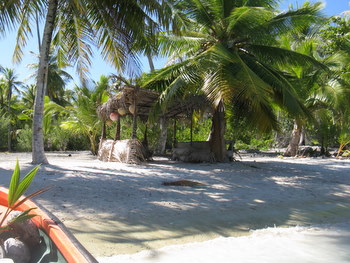 Picnic Shelter |
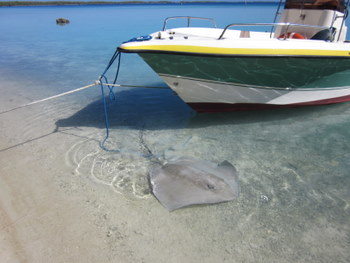 Stingray swimming close to the beach |
|
|
|
|
Meanwhile, Eugenie took charge of the meal preparation, and everyone pitched in and helped. Some of the fish that were caught were cooked on the fire, and others were soaked in lime juice and coconut milk and served raw. Most of the rest of our food came from the island - a salad made from a local succulent plant, fresh hearts of palm (which taste so much better than the canned variety!), and coconut bread. Our plates were large leaves, bowls were coconut shell halves, and we ate with our fingers. There were very few dishes to be done at the end!
|
|
|
|
|
|
|
After eating, Eugenie pulled out her ukulele and started playing it and singing. Shortly thereafter, Jean Sr. and Fernando joined in with a guitar and ukulele, and Matt played the drums (beating on the trash bin). We sat for at least an hour listening to them sing and play, and at one point Jean Jr. did a local dance. We recognized it as the "Pig Dance" which we saw when we were in the Marquesas last year. The "Pig Dance" is a depiction of the traditional way the Marquesans hunted pigs. Jean Sr. is originally from the Marquesas and taught his son the dance. When the sun started heading for the horizon, we packed up the boats and headed back to the anchorage. For us, this day had been one of the highlights of all of our travels.
|
|
|
|
We ended up spending eight days in Manihi, and we loved it. Although the snorkeling was not great inside the lagoon, the drift snorkel through the pass was excellent. The incoming water was clear, there were some very nice corals, and the marine life was excellent - we saw more octopus here than we've seen anywhere, as well as lots of eels and a great variety of fishes.
Also while in Manihi, we met Xavier Michel, who runs a "sailmail" station (a radio email service similar to winlink). Xavier is retired from the French Navy, and in his last position, he was the Commander in charge of the French Navy fleet throughout the entire Pacific. He and his wife are building a home on one of Manihi's motus, and it uses only "green" power - from a wind generator, solar panels and a water turbine. Xavier is a very warm and charming gentleman, and he welcomed us to visit his home and showed us his sailmail station.
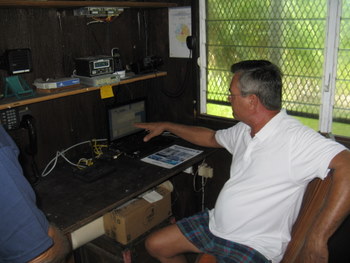 Xavier Michel at his Sailmail Station |
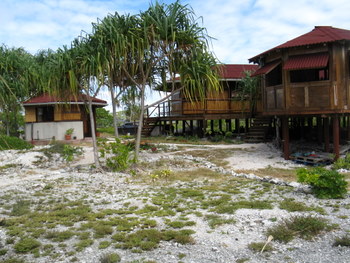 The beautiful home Xavier and his wife are building on one of Manihi's motus |
Although we loved Manihi, we understand some of the complaints we hear about it. As mentioned previously, the water in the anchorage was green and the nearby corals were dead - maybe caused by run-off from the town? Also, the anchorage is deep, and it has a lot of coral to snag the anchor and/or chain. This is a place where mooring balls would be a great benefit because to untangle a snagged chain or anchor one needs either a scuba tank or the ability to free dive to about 60 feet, which Fernando can do, and he helped our friends on Infini untangle their anchor chain. (We were quite lucky and did not snag our chain or anchor here!) Although we enjoyed the snorkeling in the pass, there is some damage to the coral reef, and when snorkeling with the incoming current, one has to be careful not to get caught on a couple of abandoned fish cages near the end of the drift. They are ugly and hazardous.
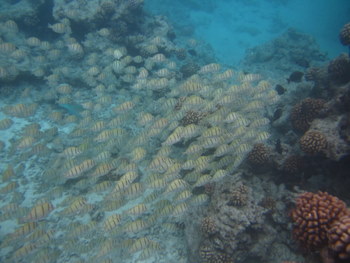 School of convict tangs in Manihi's pass |
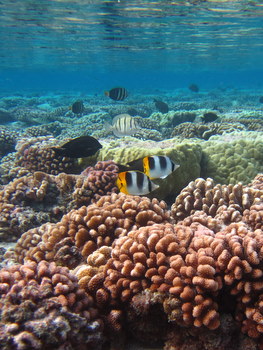 Clear waters, healthy corals and a variety of tropical fish |
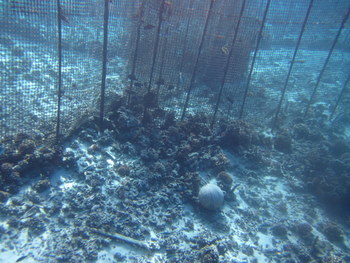 The ugly and dangerous fish cages |
| Fernando was really responsible for making our visit to Manihi so memorable. He is the ultimate ambassador. He wears many hats - he's the town baker, the head of the Mormon church on the island, the local sales rep for Herbal Life, he works at the airport when flights come and go - and he's as honest as the day is long. Before going on the picnic, we had agreed to pay for gasoline for the boats since he needed to borrow a second boat to haul all of us out to the picnic site. When he came to collect, he showed us the bill from the gas station so that we knew exactly what it cost. He never asked us to pay for escorting us in the pass and to the anchorage, but we offered to do so because we didn't want him to feel we were taking advantage of him, and we agreed on a price that was significantly less than we saw on his price list. We needed some diesel while we were there, and Fernando delivered it to us and charged us a fair price. Although we didn't request it, he brought baguettes to us in the anchorage several times, and they were always gifts. Whenever we saw him, he had a smile on his face. We hated to say good-bye. |
|
| Passage from Manihi to Rangiroa
Atoll (May 21-22, 101 nm, 25 hours). As we started to plan our
departure from Manihi, we had several almost windless days. We didn't want
to motor, so we waited until the wind picked up enough so that we could sail,
and
Slip Away and Infini left Manihi together headed for Rangiroa. We had
light winds (mostly 8-12 knots) directly from astern. It was a rolly
wing-and-wing sail, but it had us going the perfect speed - 4 to 4½ knots -
to arrive just in time for slack water at Rangiroa's Tiputa pass, and we entered the lagoon with no problems.
Rangiroa (May 22 to June 13). Rangiroa is the largest atoll in the Tuamotus and the third largest in the world. It is approximately 40 miles long by 17 miles wide - large enough to fit the island of Tahiti inside it - and the lagoon is ringed by 240 motus. There are two deep-water passes into the lagoon - Tiputa and Avatoru passes - both located on the north side. We visited and scuba dived here on our honeymoon in 1999, and we were excited to be coming back. We anchored Slip Away off the beach just in front of the Kia Ora Resort where we stayed 12 years ago, but it was undergoing a major renovation, so we weren't able to wander around the resort and reminisce. We were eager to get to Rangiroa for a couple of reasons. First, our nephew Chad (son of Rich's brother Ron and his wife Kim) was coming to visit and would be arriving in about a week. Also, we were very eager to check up on the sailboat Mohini, which was anchored there. |
|
Mohini is a catamaran owned by our friends Russ & Anne. We first met Russ & Anne in the boatyard in Riviera Beach, Florida, in 2007 when we were installing Slip Away's new engine. We kept in touch and our paths crossed a couple more times - in Florida again later in 2007 and then in Belize in 2009. We were excited that Mohini sailed to French Polynesia this year, and we were planning to meet up with Russ in the Tuamotus. Annie doesn't care for long passages, so Russ had other crew aboard from the Galapagos to the Marquesas. His crew left in the Marquesas, and Russ was sailing single-handed through the Tuamotus to Tahiti, and Annie was intending to fly into Tahiti and meet him there. We heard from Russ after he arrived in the Marquesas, and we let him know our intended route and timing through the Tuamotus in the hopes that we would meet up. And then Russ went missing. Annie grew concerned when she didn't hear from him for over a week. Russ uses winlink email, so he can send emails through their SSB radio, and it was quite unusual for him to be out of touch. We also sent him a few emails and did not hear back. Since our radio was not working, we went on board Infini several times to use theirs, asking boats participating in the radio net if anyone had seen Mohini or Russ. He was last seen in the Marquesas, and a couple of folks thought he didn't look so good, but he insisted he was fine and reportedly left the Marquesas headed for the Tuamotus. The Marquesas to the Tuamotus is about a 4 day passage, and by now no one had seen or heard from Russ in two weeks. The Gendarme (National Police) were notified, and everyone was on the lookout for him. He was finally found anchored in Rangiroa. The Gendarme went to the boat, spoke to him and thought he was OK, but when he found a phone and called Annie, she knew something was terribly wrong. He was very confused and had trouble speaking clearly to her. The local yacht agent, Cindy, who was handling the official paperwork for this year's fleet of boats arriving in French Polynesia also spoke to Russ on the phone. She too knew something was wrong, and she called the Gendarme and insisted they take him to see a doctor. The doctors in Rangiroa evaluated Russ, and it appeared to them that he had had a stroke. The stroke had not affected him physically, but it did affect his mental capacities. The doctor in Rangiroa put him on a plane to Papeete for further evaluation, and Annie flew there from the U.S. as quickly as she could.
We were still in Manihi when Russ showed up in Rangiroa, but s.v. Pua'Ena had headed to Rangiroa from Manihi a few days ahead of us. They were very aware of our concern for Russ, and when they arrived in Rangiroa, they did what they could to help Russ. Erik (a crew member on Pua'Ena) volunteered to watch over Mohini when Russ needed to fly to Papeete. (The biggest concern for a boat at anchor is keeping the batteries charged, so that all the systems continue to run.) When we arrived, we would take over the care of Mohini because Pua'Ena was sailing on to Papeete.
After Russ' evaluation in Papeete, it was determined that he needed to fly back to the U.S. for additional tests, treatment and rehabilitation. Mohini needed to be moved to Papeete (200 miles away) so she could be safely stored and plugged into a marina. Given the circumstances, everything worked out about as well as it could have. Erik & Betty (crew from Pua'Ena) were qualified and available to move Mohini after they completed their commitment to sail with Pua'Ena to Papeete.
Shortly after arriving in Papeete on Pua'Ena, Erik & Betty flew back to Rangiroa for Mohini. Rich spent some time with Erik helping him to figure out and familiarize himself with Mohini's systems before they took off. At Russ & Annie's request, we had a small party on Mohini the night before Erik & Betty departed.
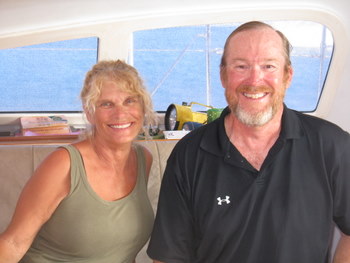 Mohini's delivery team of Betty & Erik |
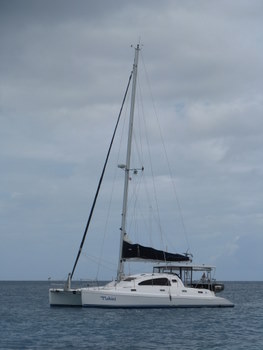 Mohini |
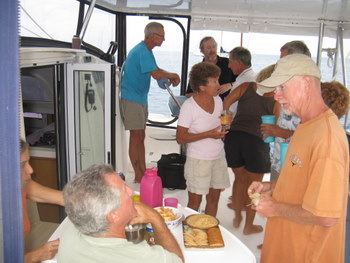 Gathering of friends on Mohini before Erik & Betty's departure |
Russ & Annie are now in San Diego, and Mohini is being looked after in a marina in Papeete. We can't begin to express how amazed we are that Russ made it to Rangiroa and safely entered the pass given his condition, but although some of his mental functions were affected, others were operating quite normally. Fortunately, navigating and operating the boat worked just fine for Russ. Unfortunately, he had problems using his laptop computer and radio, so he could not communicate with his family and friends. Russ is unable to recall exactly where he was during the two weeks he was missing, but he told us he remembers stopping and anchoring at two other atolls before Rangiroa. We are hopeful that Russ will make a full recovery and that he will be back on board Mohini in the not-too-distant future.
Chad's visit (May 28 to June 5). Mohini departed Rangiroa on the morning slack tide, and at noon that same day, we were at the airport to pick up our nephew Chad, who was coming to visit for eight days. Chad is 18 years old, a recent high school graduate, and he had just gotten his scuba certification. He traveled 28 hours from Jacksonville, Florida, to Rangiroa, but there was no time for him to rest. That afternoon, we had happy hour on Infini and then we were invited to Marionette IV for dinner. The next morning, we dinghied over to the "Six Passengers Dive Shop" and made a reservation to scuba dive the next morning. That afternoon, we did a short drift snorkel in the pass and then spent some time snorkeling at the Aquarium, a great spot just inside the Tiputa pass with no current and lots of fish life.
Over the next three days, we did three ocean dives with the dive shop. Our friends Don & Paulie on Storm Haven joined us, and we had our own private group. We did our first two dives on the reef outside the pass, and the third and final dive was a drift dive through the pass - all of them were outstanding! We had dolphins visit us on every dive - they actually swam up and circled us as if to say hello before swimming back out into the deep blue. We met a very friendly turtle who let us pet him under the chin. On one of the dives, a huge manta ray swam right over us. We saw a few sharks on the first couple of dives, but on the drift dive through the pass, we saw a lot of them (although not as many as we saw in Fakarava). When we weren't looking at the big stuff, there were lots of other smaller fishes to see and the coral reef was beautiful. These were Chad's first three ocean dives, and he did quite well, appearing fairly relaxed and in control. We are concerned, though, that his future dives will not measure up to these!
|
|
|
|
|
|
|
|
|
|
| During Chad's visit, we also had a very special reunion with another cruising couple - Iain & Aly on Loon 3. We met Iain & Aly in our first year of cruising in Mexico. After Mexico, we cruised with them along the Pacific Coast of Central America, and they line-handled for us on our first Panama Canal transit. They also took us camping for 10 days in the Canadian Rockies in the summer of 2007. Iain & Aly sailed to the South Pacific a year before us, but they were now sailing Loon 3 back home to Vancouver, Canada. The first leg of their journey took them from New Zealand to Tahiti, and they stopped in Rangiroa for a few days before continuing on to Hawaii. We were incredibly happy to once again share an anchorage with our friends the "Loonies." |
|
Blue Lagoon (June 2 - 4). After our three days of scuba diving with Chad, we got a really lucky break in the weather when the tradewinds shut down for a couple of days. We took this opportunity to head down to the Blue Lagoon, which is about 20 miles away from the Kia Ora Anchorage. The Blue Lagoon is a lagoon within the lagoon, and it is a highly recommended spot to visit, but the anchorage there can only be used in settled weather. Infini headed down to the Blue Lagoon a day ahead of us, and since winds were so light, Loon 3 put off their departure for Hawaii for a couple of days and joined us on this excursion. On our way to the Blue Lagoon, we stopped and anchored at the town of Avatoru to get some gasoline for our outboard and pick up a few provisions. Unbeknownst to us, it was a holiday, and the gas station and main grocery store in town were closed. There was another grocery store about 2 km away, which was open until noon, and the three of us had just enough time to hoof down there to buy a few things (beer being at the top of the list, and fortunately, we had a strong young lad to carry it for us!). At least the stop wasn't a total waste of time.
The Blue Lagoon was gorgeous - an incredibly blue pool of water surrounded by reef, sandbars and pink-sand islets. We pulled our dinghies through some shallow water and into the lagoon. We collected coconuts, combed the beaches for shells, swam and snorkeled. It was a great day!
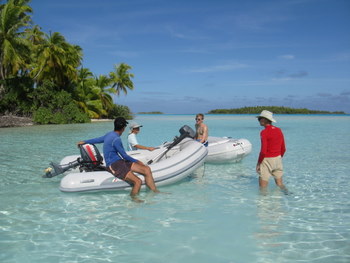 Taking the dinghies across the sand bar into the Blue Lagoon |
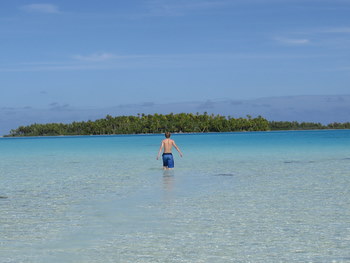 Chad headed for the Blue Lagoon |
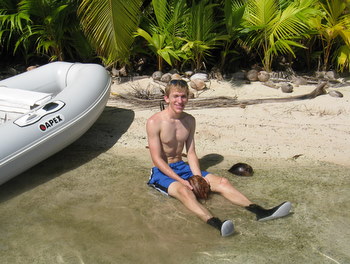 Chad on one of the coconut filled beaches |
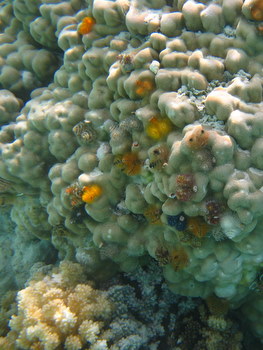 Christmas tree worms on the coral |
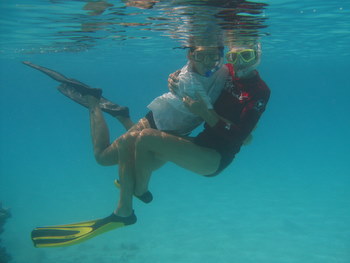 The two of us hamming it up in the water |
The next morning, we weighed anchor and headed back to the Kia Ora anchorage. Chad was flying home the following day, so we thought it best to get back close to the airport. After arriving back a the Kia Ora anchorage, we took Chad for one last snorkel at the Aquarium. We gave him some bread to feed the fish, and he was swarmed by snappers, sergeants and butterflyfish. We also had a great octopus sighting, and saw a few eels. Lots of fun!
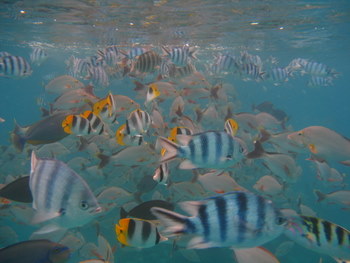 Feeding Frenzy |
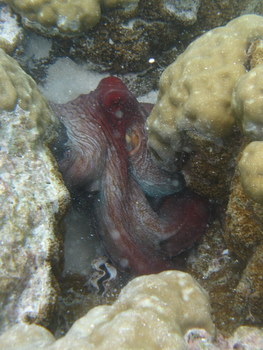 Octopus |
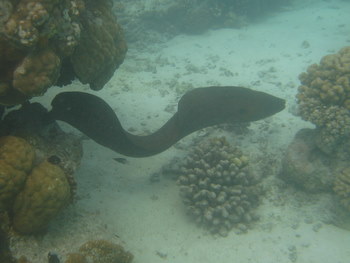 Eel swimming between hidey holes |
That evening, there was a party on Infini to celebrate Mike's birthday. Sue invited everyone on all the boats in the anchorage to the party, so it was a big gathering with people spread throughout the boat - in the cockpit, in the salon and on the foredeck. It was a fun gathering, and especially for Chad because a couple of the other boats had kids on them the same age as him, so he could hang out with them instead of us old folks! All of us met some really nice people that evening.
Early the next day, winds were still light, but the forecast called for them to build by the afternoon, and we bid adieu to Loon 3 as they weighed anchor and headed out on the morning slack tide, bound for Hawaii, 2600 nautical miles away. By late morning, we could see a bank of clouds headed in our direction - a harbinger that bigger winds and some less pleasant weather were on the way. About noon, the winds picked up to 20 knots from the southeast - perfect sailing conditions for the Loonies, but not so great for our anchorage, which got quite choppy in southeast winds. Shortly after lunch, we decided Rich should take Chad ashore and get him a taxi to the airport. It was a couple hours earlier than he needed to go, but the anchorage was already pretty rough, and we were concerned that the weather would get worse. We said our good-byes to Chad - we thoroughly enjoyed having him aboard and hope he'll come back again! We were also VERY appreciative that Chad carried our SSB radio back to the U.S. and shipped it to the manufacturer (ICOM) for repairs. It was a rough ride to the dock, but Rich delivered Chad safely (and mostly dry) ashore, and he was able to ride along in a taxi with some other folks who were headed to the airport. About an hour after Chad departed Slip Away, it poured down rain, and we were glad we weren't trying to get him ashore in that!
We spent the next two nights at the Kia Ora anchorage with 20 knot southeast winds. The anchorage was rocky and rolly, we didn't get much sleep. After the second night, we decided to seek out a better anchoring spot. Some friends had told us about an anchorage behind Motu Faama at the south end of the atoll, and given the wind direction, we thought it would be a calmer spot than our present location, so we weighed anchor and headed out.
Motu Faama (June 7 - 9). Our cruising guide recommended sailing a dog-leg route across the lagoon to get to Motu Faama, which was 17 nautical miles away. The first leg of the trip (7.5 nm) was a beam reach with 15-20 knots of wind - a good sail - but for the second leg (9.5 nm), the wind was 30 degrees off the bow, and we had to motor. We arrived at Faama and anchored in the recommended spot at the west end of the motu - not flat calm but much better than the Kia Ora, and we had it all to ourselves. It was Rich's birthday, and Jan baked him a Texas Sheet Cake. We had a nice celebration, and that night we both got a good night's sleep.
The next day, we did some exploring in the dinghy and found what we thought was the most beautiful spot we saw in all of the Tuamotus. Here was another "blue lagoon", smaller than the last one we visited, but absolutely stunning with clear blue water, volcanic rock formations and pink sand beaches. Gorgeous! We spent the entire day exploring this area - ours were the only footprints on the beaches. During our explorations, we also found a calmer anchorage at the east end of Faama, and late in the day we moved Slip Away there. Very nice!
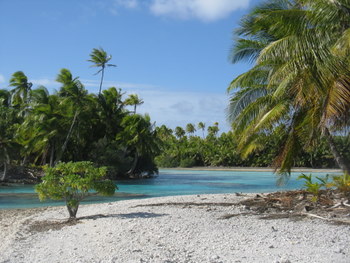 The "Hoa" or shallow passageway between motus |
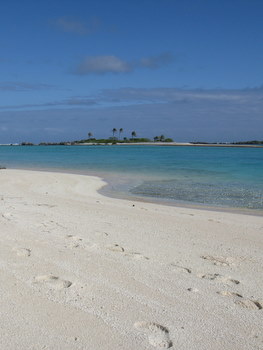 Beach and Blue Lagoon at Motu Faama |
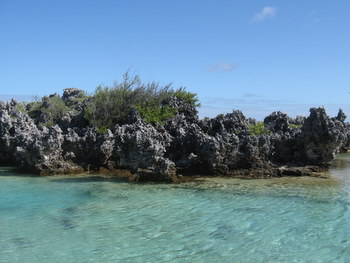 Volcanic Formations at Motu Faama |
We spent another restful night at Motu Faama, but the next morning, the winds went northeast, and the anchorage started getting choppy. The Kia Ora anchorage is great in northeast winds, so we weighed anchor and sailed back. This time, we didn't take the dog-leg route - we just sailed straight across the lagoon - and by doing so, we could sail the whole way. We kept a good lookout and saw no obstructions along the way, so we're not sure why the cruising guide recommended that dog-leg route.
As we approached the Kia Ora anchorage, Mike on Infini called us on the VHF radio to let us know that he had received an email from Iain & Aly on Loon 3, and they asked him to relay a message to us - they had broken their forestay and turned back. They had the situation under control by securing the rigging with halyards, but they needed to make repairs before they could sail to Hawaii. This was bad news and a serious situation - a broken forestay can cause the mast to fall down - and they were about 3-4 days away from arriving back in Rangiroa.
We spent a few more days at the Kia Ora anchorage, watching the weather and keeping tabs on the Loonies. Since we had internet access in this anchorage, we could communicate via email and track their progress, and we also talked to them a couple of times on other boats' SSB radios. We had planned to leave for Huahine (200+ nm away) on the next weather window, and the weather window arrived, but we were dragging our heels. Iain & Aly told us not to wait for them, and although there was not really much we could do to help them, we struggled with leaving before they got back safely. Our weather window held just a bit longer, and the Loonies got back more quickly than anticipated, so we were still there when they arrived back in Rangiroa. And while we were waiting, we spent time with some of the folks we recently met and made some new friends.
| When the Loonies arrived back at
Rangiroa, we did our best to make ourselves useful. They called us on the
VHF radio when they got in range (about 10 miles out), and the timing of their arrival was perfect for almost
slack water in the Tiputa pass. We went out to the pass in our dinghy,
checked out the conditions and
radioed back to them that it was calm, and they could proceed with no worries. As they came in the
pass, we led them through the narrower west side branch which had sufficient depth
and calmer water than the main section. When they dropped their anchor,
there was a big sigh of relief. We climbed aboard and gave Aly big, long
hugs. Iain said he'd hug us later after he had his shower! They both
handled this ordeal very well, but there was no doubt that the past few days had been
extremely stressful for them.
That afternoon, we helped the Loonies take down their headsail, roller furler and broken forestay. Iain had a contact in Papeete who could send him a new forestay, and he planned to call him to order it the next day. (Unfortunately, the next day was yet another holiday, but he was able to order it the day after.) That evening, we made dinner on Slip Away, and by then Iain had showered, so he gave us our hugs. We shared a few rum drinks, and our conversation drifted away from broken boat equipment to books and travel. We made it an early evening because they were exhausted and we were leaving the next morning. When they went home we could see the stress starting to fade from Iain & Aly's faces, and they told us they slept really well that night. We left the next morning for Huahine. We wouldn't have minded staying a few more days to help out the Loonies, but our weather window was evaporating, and if we didn't leave, we would have to motor the 200+ miles to Huahine or wait until the next weather window (and it was not yet apparent when that might arrive). Neither of those options looked great to us, and we knew Iain & Aly were quite capable of taking care of themselves, and they insisted we go. So we said our good-byes once more, weighed anchor and headed out the Avatoru pass on the morning slack tide. |
|
When we left Rangiroa, we were leaving the Tuamotu Archipelago behind and heading to the Leeward Society Islands of French Polynesia. The terrain would change from flat sandy islets topped with coconut palms to high volcanic islands covered with all sorts of vegetation. We were looking forward to bigger grocery stores with better prices and a selection of fruits and vegetables that included more than potatoes and onions. We would no longer have to time our arrival at an island for slack tide, and that was a relief! But we would miss a lot about the Tuamotus - the best diving in French Polynesia, the unexpected pleasure we found sailing inside the atoll lagoons and especially the people of the Tuamotus who were so friendly and welcoming to us.
